
|

|
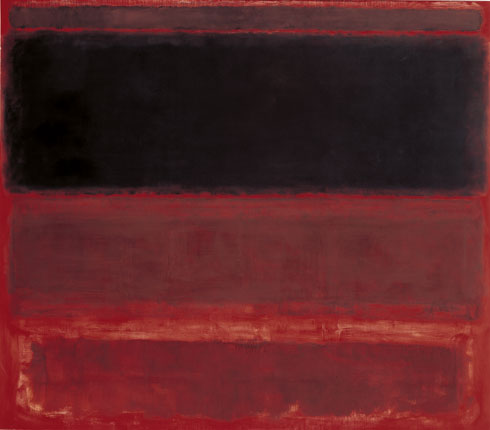
Mark Rothko, Four Darks in Red (1958). Whitney Museum of American Art, New York.
© Kate Rothko Prizel and
Christopher Rothko/DACS 1998.
Introduction
By
Deanna Sirlin
Editor-in-Chief
The Art Section
Welcome to the February 2009 TAS. I do not know if many of us in this unusual time both in the art world and the world
at large are thinking about things if not in identical ways, than at least in ways that form a collective unconscious where
the whole is greater than the parts. Such a collectivity of thought is evident in this issue.
This month’s writers do not know each other, do not live in the same countries, and I am quite certain were educated
in different places. Yet their individual paths have led them here to reflect on a time in the art world of 50 years ago,
circa 1958, and the ebb and flow of the different aesthetics of that time and the connections between artists in New York,
California, and Europe. The overlaps among their articles are subtle, yet uncanny.
It is true that whereas Anna Leung’s and Robert Stalker’s respective contributions are historical reflections,
Giuseppe Gavazza writes about e/static, a space in Turin, Italy that is devoted to the art of the immediate present. Nevertheless,
both he and Carlo Fossati, the director of e/static, often think about art in relation to the innovations of John Cage, Fluxus,
and George Brecht.
It is for confluences like these that I created TAS, and I so appreciate the thoughts and work of all our writers who
have generously allowed myself as editor to bring them together for a richly multi-dimensional reading.
All my best,
Deanna
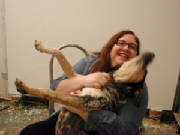
www.deannasirlin.com
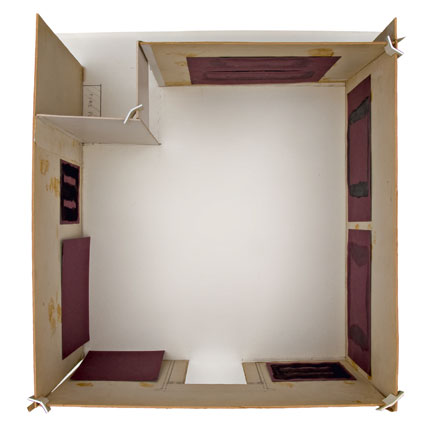
Maquette for installation of Seagram murals at Tate Gallery. Tate Archive Collection.
© Kate Rothko Prizel
and Christopher Rothko/DACS 1998. Photo: J.Fernandes, Tate Photography.
Mark Rothko: The Late Series
At the Tate Modern
by Anna Leung
This exhibition is about much more than Mark Rothko. It touches on various presuppositions regarding the ground rules that,
even if covertly, define our reception and interaction with art works in general. And whereas it is impossible for me to delineate
a Rothko that is appropriate for you and approximates your response, since Rothkos do not permit any mediation, it is possible
to consider certain tendencies within the art world that help determine the way we look at the late series of Rothko paintings.
Since art history is essentially a retrospective discourse that constantly defers to the present moment, current attempts
made to make intelligible new movements or innovative stylistic practices will necessarily be subject to revision by subsequent
generations. The idiom changes, and with that comes the need to re-construct what has gone on before us. The critical reaction
to Rothko's work testifies more than most to the way abstract painting simultaneously invites and resists individual interpretation.
Despite the initial cries of the emperor’s new clothes in the 1950’s and the quip as to how a set of blurry rectangles
could ever constitute Art, Rothko’s paintings were being heralded as part of the Abstract Sublime, placed in the same
Northern romantic trajectory as Friedrich and Turner, and elevated to the status of secular icons by the early 1960s. Ten
years later, in 1971, the black, brooding canvases that make up the Rothko Chapel in Houston seemed to fulfill this mystical
impulse but also could be seen as pointing in another direction more in line with the new generation of Minimalist artists
whom Rothko would feel were threatening to usurp his place.
But by this time, the orientation of critical responses
to his work had already begun to change. Whereas earlier critics focused on luminous zones of colour creating a transcendent
space, what was increasingly alluded to was a purely aesthetic object closer to the elegance of French symbolism, for instance
to Monet or to Whistler, a decorativeness which Rothko energetically sought to deny. He always asserted that he was no colourist
and indeed no abstractionist. This anti-transcendental tendency went much further: as with Stella’s ‘hard edge’
abstractions, what was beginning to characterise avant garde painting was its insistence on painting’s status of a concrete
material object. Rothko may have partly ratified this move as a reaction against the emphasis on pure opticality in colour
field painting, which was itself derived from the formal analysis of Abstract Expressionist gestural painting. In other words,
with his harder edged Monochromes of the mid sixties, Rothko may have been partly assuming paternity for this new generation,
or at least competing with them on his own terms whilst disavowing any real relationship. This conflict between a romantic/mystical
understanding of abstraction and a reductionist and totally non- associative abstraction, which may well have become a source
of inner conflict for Rothko, was not new. The precedent had already been set in the early years of the twentieth century--not
in America, but in Russia.
Contrary to what one might think, abstraction does have a narrative--many narratives,
in fact, ranging from the primary distinction between geometric or mechanistic abstraction (Malevich and Mondrian) based on
rationality, and organicist abstraction (Kandinsky) based on irrationality, to further subdivisions that lead ultimately to
the Monochrome, which has been associated with the death or end of modernist painting or at least a decline that overshadowed
much of the late twentieth century. What is at stake is the idea of a high art through which we can gain some sort of transcendence,
art, in Barbara Rose’s words, as "a catharsis of the imagination." This debate had already raged between Malevich and
Rodchenko in revolutionary Russia. Rodchenko spearheaded an anti-art movement that was fundamentally a gesture of defiance,
affirming "It’s all over. Basic colours. Every plane is a plane, and there is to be no more representation." Malevich,
though mechanistic, instilled his all-white canvases with extra-aesthetic associations based on Ouspensky’s ideas on
consciousness and the fourth dimension. Neither was an absolute monochrome painter; each argued for an extra-aesthetic agenda.
The American monochrome painting can be seen as a logical outcome of Abstract Expressionist all-over painting: a
single-coloured, unmodulated surface that began to move away from the evocative and romantic overtones still found in Barnett
Newman and Rothko. Robert Rauschenberg’s white paintings, completed at the Black Mountain College under the auspices
of Joseph Albers and John Cage, also still echo this mystical overtone. We have no real means of knowing whether these new
developments constituted a motivating factor in Rothko’s subsequent negation of colour that characterises these last
series of paintings on display at Tate Modern. It is possible that Rothko was well aware that Reinhardt’s Black Paintings,
a series of monotonal black paintings, each made up of four almost invisible black squares, which the artist had devoted
himself to from 1961 to his death in 1967, represented both an end and a new beginning. For Reinhardt they were "the last
paintings that anyone can paint." Certainly Rothko was both impressed and threatened by such a degree of purism and commitment
to one format that rigorously excluded subjectivity, but as this exhibition suggests his own monochromatic paintings could
have just as feasibly been the product of his own experiments and observations regarding Gestalt perception theory, in which
he had long been interested. For what this exhibition seems to suggest is that from the Seagram Collection till his death,
Rothko was involved not with creating canvases as unique works of art but as parts of series that would demand of the viewer
a completely different interaction with his work. From the late 1950s on, installations made up of a series of paintings within
a given location became the focus of his painting practice. Thus in the Houston Chapel, while his paintings were still designed
to be intimate and invite contemplation, as a totality they create a drama that is enacted within a public space over which,
unlike the Seagram Murals, he was able to exert a clear control.
The Seagram Murals
In 1958 Philip Johnson and Phyllis Lambert approached Rothko with a view to his painting a set of murals
for the Four Seasons Restaurant in the prestigious new Mies van der Rohe Seagram Buildings in New York City. He was given
carte blanche and asked to provide 500-600 square feet of paintings for $35,000. It is significant, though, that from the
beginning of negotiations he was very careful to provide himself with a get-out clause since, suspecting that the decorative
nature of the project would cause him to as bastardise his talents, he harboured extremely ambivalent feelings about the commission.
Rothko, who had definite leftist leanings, belonged to a generation of artists for whom success spelt out guilt. Acceptance
on the part of the public, let alone accessibility, were still seen as somewhat dishonourable. According to this logic, if
art was to be effective it was by definition unapproachable, unsettling, and disharmonious. To Rothko, for whom "all art deals
with intimations of mortality," painting represented a quest, not for self expression but, on the contrary, for self negation.
Painting was an attempt to create an image of the not-seen while at the same time insisting on art’s sensuous particularity.
A constant danger besetting the Abstract Expressionist artist was of the painting's losing its gesture of negativity and abstractness
and becoming familiar or even beautiful in a decorative sense, and thus sliding into kitsch. Rothko, exasperated at being
labelled a colourist with its associations of something overly refined, delicate, or even hedonistic, therefore abandoned
his earlier bright hued colours for darker crimsons and blacks. Only seldom did he return to the luxuriance of colour with
which he made his name.
Over the next three years Rothko completed three groups of paintings that represented a
move away from his classic horizontally zoned compositions. According to his studio assistant, a break-through came after
turning some of his paintings on their sides so that what was originally a horizontal bar now functioned as a pillar and made
the forms resemble portals. This suggested an architectural model based on the open rectangle that reminded Rothko of Michelangelo’s
Laurentian Library in Florence with its blind window constructions. Perceptually, these forms which, in the absence of any
definite figure and ground, function simultaneously as surface and deep recessive space, invite and yet repulse entry. (This
incidentally satisfied what Rothko called his malice towards the restaurant’s affluent diners. For it was not so much
that the Four Seasons was a restaurant but the class of clients who came to eat there at such inflated prices that enraged
him.) In the final analysis, Rothko rejected the commission realising that a restaurant was not an appropriate venue for his
paintings. But much had been gained. The idea had been to create a total environment which would surround the viewer and give
Rothko complete control over how each painting in the series was to be hung, so that "the neighbouring paintings would always
intrude on the viewer’s peripheral vision." Rothko imagined an ambiguous space created by a palpitating screen of paintings,
so disorientating in its effects that, as he said, the diners would want to "butt their heads forever against the wall." Eventually,
Rothko returned the money and withdrew his paintings. He had already painted 40 panels. The paintings were dispersed, 13 to
be housed in the National Gallery of Art in Washington, DC, 7 at the Kawamura Museum of Modern Art in Japan, and 9 in the
Tate here in London. Rothko died on February 25th 1970, the very same day the Seagram paintings arrived in London.
The Rothko Chapel at Houston
What Rothko had achieved through his work on the
unfulfilled Seagram commission was the creation of a series of paintings that required to be experienced by the viewer as
a totality, an innovatory concept that he worked through in his next installations for Harvard and then for what was to become
the interdenominational Rothko Chapel at Houston, Texas. Rothko received this commission, his last, in 1964 from John and
Dominique de Menil. Asked to paint a set of murals for a modern octagonal chapel in Houston, Rothko was inspired in his treatment
of the space by early Byzantine architecture. Moreover the windowless octagonal space gave Rothko the opportunity to experiment
with a wraparound solution that made it virtually impossible, if scrutinising one painting, not to simultaneously be aware
of adjacent paintings on either side. The viewer would then be integrated or enfolded into the work so that it would be experienced
as one work--or, rather, one continually changing event--even though it was physically made up of several panels. The time
it took to register differences was an essential part of the work. A virtually black rectangle seems to take up almost the
entire canvas making up each of the five single panels and the three triptychs. What particularly distinguishes this set of
paintings is the absence of soft edges and the sensuality associated with his earlier work. Rothko had used masking tape to
define his rectangles. Only gradually do other colours begin to infiltrate or surface, an effect that depends on the natural
light coming in from the overhead aperture; when overcast, the black rectangles look all the more obdurate whereas on lighter
days this black expanse begins to dematerialise. In both cases, access seems difficult. Many viewers report difficulties,
psychological as well as optical, in actually looking at the paintings, for they seem to resist prolonged viewing and therefore
can never be fully grasped. The intense austerity of the paintings seems to ignore us and yet commands our attention and
viewers are constantly brought face to face with the paradox of what they see, what they think they see and what they feel.
Confronted with a world that is simultaneously open and expansive yet closed and confined, they are presented with a space
that oscillates between being and non-being.
To obtain these effects Rothko had already experimented with series
of closely related canvases in which visibility, constantly threatened by invisibility, provokes in the viewer a continually
shifting response to paintings that seem alike but are not quite the same. As in the Houston chapel, this can be a struggle
since it’s almost impossible to remember quite what we have seen when surrounded by paintings on all sides. What matters
is the interaction between paintings that present us with a multiplicity of permutations, a play of tensions that bear no
relation with external life as we know it. Essentially, Rothko creates, with a minimum of means, an internal experience that
can induce a state of anxiety or of peace - the most frequently noted response in the visitor’s book is "peace." For
curiously, however sombre, Rothko’s dark colours continue to emit light.
The Brown and
Grey, Black on Grey
Rothko had worked for three years on the Houston chapel, and to encourage experimentation,
he started to work with acrylics on paper. In 1968 he suffered an aneurysm and continued to restrict his work to a maximum
of 40 inches in height, either out of his liking for the new freedom found in working with paper or perhaps because of medical
advice (not to over exert himself). Dividing the vertical sheet of paper into two sections resulted in two horizontal areas;
the upper section in the first series was painted with a brown wash while the lower was painted grey. In the second series,
a black wash covered the upper section while grey covered the lower one. The distinguishing mark of these paintings is the
white border created by the use of masking tape. The luminosity they emit is related to the fact that Rothko now left the
painting surface white rather than using gesso mixed with coloured pigment as he had previously done. Both areas are firmly
anchored in this white edge that effectively frames them, but at the same time aligns them with the wall so that the paintings
seem to puncture the walls and open into a space beyond them.
Some critics have seized upon this boxing in of the
image as a premonition of Rothko’s suicide by equating them with coffins. But this is to fall into the trap of literalism.
It was not painting that defeated Rothko. On the contrary: having battled with depression for over five years, survived an
aneurysm, been diagnosed as having bilateral emphysema, and separated from his wife and children, it was life that defeated
him. Rothko’s suicide was extremely thorough, very well thought out, and not an impulsive act. He had looked into the
darkness and concluded that there was only one way out that preserved his dignity.
The Subject
of the Artist
Rothko always refuted his labeling as either a colourist or abstractionist. He also
insisted his work revealed not his self but his "not-self." He pursued a reductionist aesthetic but not one that was formalistically
reductionist or anti-art. Despite all his self doubts, and his feeling threatened by the oncoming generation who repudiated
his ideas, he never stopped pursuing "a single tragic idea." His art, which had started out as political, gained a definite
transcendental edge but one that does not point to anything beyond the empirical world. It is concrete and material. His is
a singular voice that refused to surrender to the claims of a disenchanted world. The rationale behind the exhibition may
be to suggest a link between the asceticism of the late series and Minimalism, but Rothko's last paintings do not necessarily
represent this end point. What he continues to give us is a space for contemplation that confronts us with our existential
condition. This required both stamina and self-effacement. It was necessarily a fragile enterprise.
Text © Anna Leung, 2009.
The exhibition Rothko ran from 26 September 2008 - 1 February 2009
at the Tate Modern in London, UK.
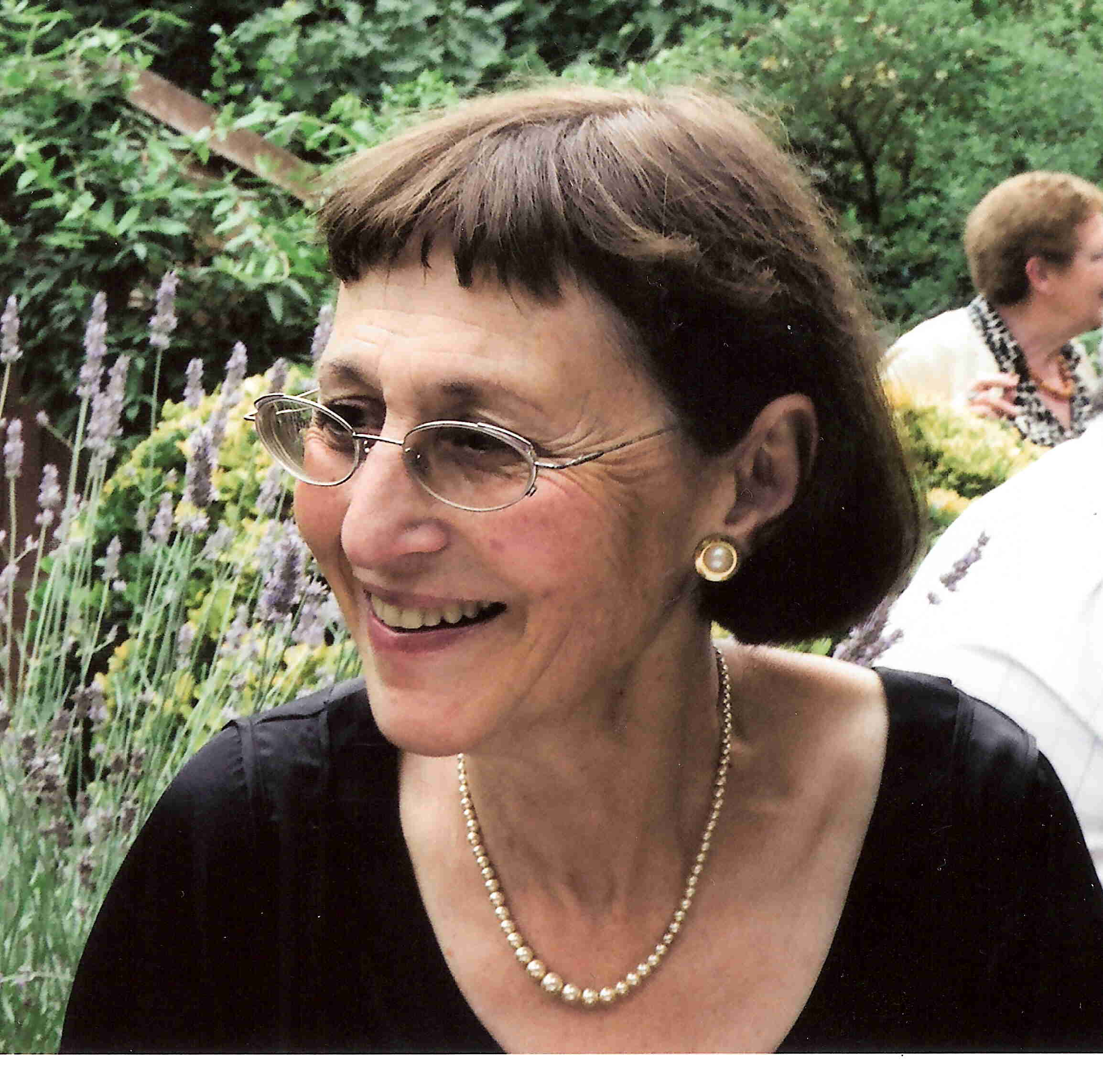
Anna Leung is a London-based artist and educator now semi-retired from teaching at Birkbeck College but
taking occasional
informal groups to current art exhibitions.
Music/art have never been static:
A brief dialogue with Carlo Fossati
by Giuseppe Gavazza
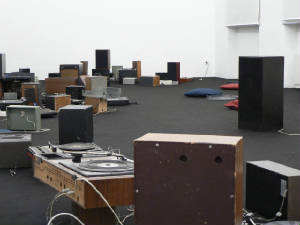
|
| Michael Graeve, Simple Methods for Complex Times(2008). Courtesy of e/static and the artist. |
Opened in 1999 in Turin, Italy, e/static is “a space for the art of the present time” (del tempo presente). The
Italian version of the website adds: “Art not unrelated nor antithetical to it (the present time), but in accord (well
tuned) with phenomena happening in reality.”
“Tempo presente” can be translated as either present
time or present tense.
The juxtaposition of the words "tense" and "static" made me think that one might consider
an ecstatic state as a form of static tension, a potential energy ready to move, one frame from a movie: a good metaphor and
paradigm for contemporary art. The present is the not yet developed future, and art can give us both lenses to look ahead
and the energy to move on.
I met with Carlo Fossati, creator and curator of e/static, in December 2008, some days
after an event of Visionair-08 (yes, with underlined on at the center of the word), Simple Methods for Complex
Times, a performance by Michael Graeve. I sometimes claim to write about "sound art" for The Art Section, but
Fossati doesn’t like the term. This provided us with a good starting point for our conversation.
e/static
is an exhibition space: a big empty, disused factory with large windows and sunlight moving through it in multiple directions.
It is a dynamic space that includes time as its inner dimension. It is simultaneously an open/closed, inside/outside site.
The space itself may reflect e/static's ongoing project of presenting "live events, generally performances, but of varying
kinds." (E/static also has another space for events and exhibitions: blank, an intimate, white first floor space not
far from e/static, where Michael Graeve's performance took place.)
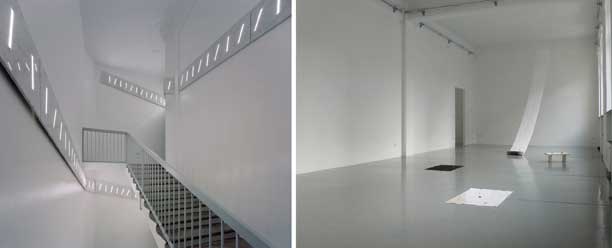
Left: Hans Peter Kuhn, Helix (2006). Photo: Gerhard Kassner. Right: Miki Yui, Hitotoki (2005). Courtesy
of e/static and the artists.
This project began in 2001 under the rubric EXIT-01, though the events have been produced under the Visionair banner
since 2004. Time is a dimension of all art (not just of music or sound) just as music (sound) needs and inhabits the dimension
of space. This, if I understand correctly, is the reason for Fossati’s dislike of the term Sound Art. An artist
of the present time has access to many different means of expression, different techniques, materials, spaces, time ….
. To define Sound Art is to reduce an area, to close an open space, to delimit a thought, to build a cage around a
moving being. Sound is but one possible material, along with glass, marble, iron, paper, plastic. In this context, I can
see that Sound Art probably isn’t a compelling category.
Most artists choose some media, material, or
techniques with which to develop a personal language, but this doesn’t mean there has to be a category and a label for
every approach. In an interesting text of April 2005, Breve storia dell’occhio e dell’orecchio [A Short
History of the Eye and the Ear], Fossati wrote,
Sound appears in art beginning with certain avant-garde
experiences of the early 1900s. Its history is the same as of all those other elements belonging to the natural world, like
the living body (especially its strongest, most "natural" and fluid part: blood); animals, living or dead; earth, water and
fire. . . . It was as if sound was caged in the hierarchical structures of music (in its Western connotation), rigidly separated
from noise, which belonged to chaos. . . . With the Fluxus artists, with Cage, with the artists associated with the "performance
art" of the 1960s and '70, sound is released from its obligations . . . and becomes a new medium at the disposal of visual
artists to use along with more orthodox elements: color, form, space. (Translation is mine)
I interpret
the logo “Space for the art of the present time” as suggesting the here-and-now of things difficult to catch,
impossible to fix, impermanent. E/static's predilection for (performative) events is coherent with this vision. In the past
five years, Visionair 04-08 has presented 25 performances:
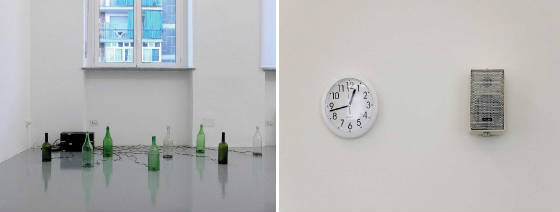
Left: Steve Roden, The moon gatherers (2002). Right: Paolo Piscitelli, At the same time (2008). Courtesy
of e/static and the artists.
-RANDOM_PLAY>: Rolf Julius, Steve Roden, Paolo Piscitelli, Hans Peter Kuhn, Akio Suzuki, Christina Kubisch, Carlos Casas,
Giancarlo Toniutti, Thomas Köner, Dominique Petitgand, Arnold Dreyblatt, Miki Yui, Paul Hendrikse, Vincenzo Cabiati, Patrice
Carré, Luca Vitone, Michael Graeve, …. PAUSE
In our conversation Fossati told me: the fascination of Tempo
presente, the fugitive instant, is in the revelation of the unexpected in the performed act. This reinforces the theme
of the contemporaneity of music I discussed earlier in The Art Section, because sound lives in the present (like memory of the past and expectancy of the
future). This attention to sound as the revelation of the extraordinary voice of ordinariness (as in the Julius work just
under my eyes/ears during this conversation) made me think about the cage of the standard concert situation in which the public
attends only if there is no risk of surprise, to meet again something well known (the same beach every year; the same pub
with the same friends; life is an enclosed courtyard, not a path to walk). The traditional concert offers the ease and certainty
of a static situation in which I know what will happen, as in a domestic place. No surprises, please! Music is to relax my
mind, to give my body the energy to dance, to let my fantasy create a soap opera to evade (avoid) my “normal”
life. Why should music/sound stimulate my mind to reflect or to think?
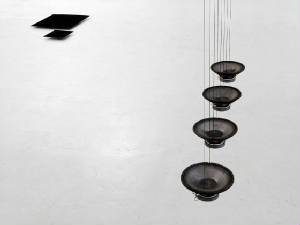
|
| Rolf Julius, 2 x Black and Volcanoes (2001). Courtesy of e/static and the artist. |
Is art a bridge from one present to the next? A bridge is something firm and anchored. “Like a bridge over troubled
water/I will ease your mind.” So good, what a solace. But music can also be Kafka’s bridge: alive, un-static:
“It was toward evening one day- was it the first, was it the thousandth? I cannot tell- my thoughts were always in confusion
and perpetually moving in a circle. It was toward evening in summer, the roar of the stream had grown deeper, when I heard
the sound of a human step! To me, to me.” (If you don’t know Kafka’s short story “The Bridge,”
please read it: it’s a masterpiece.)
This year, 2009, ten years after e/static opened in 1999, a big empty,
disused factory with large windows and sunlight moving around inside it, a dynamic space that includes time as its inner dimension,
with its blank satellite, via Parma 31/via Reggio 27 – Turin, is still a place for present tension.
Music/art
cannot be static.
I deliver from the Cage: 2009, Happy new ears (thanks to John for this quotation).
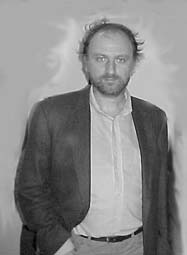
www.giuseppegavazza.it
Giuseppe Gavazza
is a composer who lives and works in Turin, Italy.

Video still from A Glimpse of Circa 1958 by Jarrard Cole, Rachel Scall and Dioni Wise.
Published in The Daily Tar Heel, October 3, 2008. Painting: Morris Louis, Theta Beta (1960). Ackland Art Museum, Gift of Marcella Louis
Brenner. ©1993 Marcella Louis Brenner.
Re-making the Readymade:
American Artists Circa 1958
by
Robert Stalker
Why was it that following World War II American artists were suddenly receptive to the ideas and strategies of European Dada
in a way that their immediate predecessors such as Pollock, de Kooning, and Rothko hadn’t been? The dramatic change
in the art market following World War II offers one explanation. Post-war economic prosperity helped to fashion a rapidly
growing U.S. market for contemporary American art. The famous August 1949 Life magazine photo-essay on Jackson Pollock,
an artist who had struggled in anonymity for years, typifies the increasing commercialization of American art and artists
in the post-war years. Arguably, post-war American artists began to see the relevance of the historical avant-garde for a
critique of the rapidly expanding consumer culture in the U.S. Bringing together 62 works by 57 artists to chart two major
trends in post-war American art—the development of hard-edge or post-painterly abstraction and the emergence of assemblage
art— the Ackland Museum’s recent exhibit Circa 1958: Breaking Ground in American Art illustrates the various
ways in which American artists on both coasts began assimilating avant-garde models of art making into a powerful critique
of the increasing commercialization of American culture.
With the aesthetic and commercial triumph of Abstract Expressionism,
many believed that gestural abstraction was becoming trite and mannered. Painters such as Kenneth Noland, Frank Stella, and
Agnes Martin, all included in this exhibit, responded to what was beginning to look like mere affectation in the work of some
second generation Abstract Expressionists by avoiding altogether the gestural brushwork that Clement Greenberg would soon
dismiss in his catalogue essay for Post-Painterly Abstraction, an exhibition he curated for the Los Angeles County
Museum in 1964, as the “Tenth Street touch.” Focusing instead on imagery culled from what Jasper Johns called
in reference to his paintings of targets, flags, and numbers, “things the mind already knows,” this younger generation
of artists drew on a kind of readymade aesthetic to develop a mode of painting that was austere, impersonal, and coolly formal.
Kenneth Noland’s That (1958-1959), for example, a vibrantly colored target, retains, much like Johns’s
work, only the vestiges of gestural abstraction in the dribbles of paint in the target’s outer ring. Rejecting also
the “all-over” technique and painterly brushstroke of the New York School, Noland, following Helen Frankenthaler,
deploys a staining technique that purges the work of almost all traces of the artist’s hand, leaving us with an image
that looks almost manufactured or “readymade.” In Blue Horizon (1958), also on display, Frank Stella,
directly inspired by Johns’s now-legendary 1958 show at the Leo Castelli Gallery, similarly retains hints of Action
Painting in his use of drips and impasto but, in his predilection for the repeating horizontal stripe pattern, sidesteps New
York School expressionism in favor a more premeditated, almost mechanical, aesthetic. Likewise, the smooth, misty gray and
white rectangles of Agnes Martin’s This Rain (c.1960), another painting on exhibit, are devoid of expressionistic
color and painterly technique. Like Noland and Stella (or, for that matter, Kelly, McLaughlin, and Ryman, artists all represented
in Circa 1958), Martin opts for an austere, impersonal, and literalist approach to painting, challenging the increasingly
popularized image of the artist as miner of a buried, and often tortured, psychic life.
As another way of puncturing bourgeois conceptions about individual creativity and expression, artists also turned toward
the Dadaist interest in collapsing the boundaries between art and the everyday. Perhaps no other figure had as much influence
on this direction in post-war American art as John Cage. A major conduit of avant-garde ideas, Cage was developing by the
early forties something of a “found” aesthetic by incorporating into compositions such as Credo in Us (1942)
bits of pre-recorded music, speech, and other sounds. His composition for prepared piano entitled Music for Marcel Duchamp
(1947) paid homage to the Dadaist roots of this direction in his music. But it was, of course, Cage’s now-canonical
“silent piece” 4’33”, first performed at maverick Concert Hall in Woodstock, NY, 1952, that
would most directly impact post-World War II visual culture. With its abandonment of musical notation in favor of written
instructions and in its incorporation of “chance operations,” the piece would prove crucial to the development
of artistic movements such as Fluxus, Performance Art, Minimalism, and Conceptual Art.
Having studied with Cage
at the New School for Social Research, the Fluxus artist George Brecht (who died on December 5, 2008) developed his idea of
the “event score” directly from Cage. Brecht’s Three Chair Events (1961), included in the Ackland
exhibit, consists not of objects created by the artist but rather of an “event score” outlining the placement
of three chairs around the gallery. The re-contextualization of these commonplace, even banal, objects in the gallery space
encourages the spectator’s heightened awareness of the institutions and forces that traditionally work to isolate art
from the everyday. Robert Morris’s sculpture Box with the Sound of its Own Making (1961) and Yoko Ono’s
Painting to Hammer a Nail (1961/1966), both also on display, engage similar ideas about the relation of art to the
everyday. Morris’s sculpture, a wooden box with a tape recorder inside that plays the sounds of the box’s construction,
and Ono’s “painting,” a silver board into which spectators are invited to hammer nails, both foreground
the temporality of the art work and demystify the creative process, while the sounds of sawing wood on Morris’s tape
or the hammering of nails into Ono’s canvas disrupt the decorum of the museum space in a way that resonates with Cage’s
own idiosyncratic definition of music as “what we are hearing if we are just quiet.” Morris’s Box, however,
an homage to Duchamp’s own Ŕ Bruit Secret [With a Hidden Noise] (1916), remains more enclosed and self-referential
than Ono’s Painting, whose very conceptualization provokes social interaction with the viewer.
Because it includes nearly a dozen works by West Coast artists, Circa 1958 also provides a fascinating opportunity
to compare these New York artists with the slightly different approach taken by their contemporaries in L.A. Of course, the
Los Angeles art market in the late-fifties could hardly rival New York. But L.A. did have the Ferus Gallery. Established
by Walter Hopps and assemblage artist Ed Kienholz in 1957, Ferus quickly became a hotbed of beat attitudes and advanced art,
mounting important exhibits such as “Joseph Cornell--Constructions,” “Jasper Johns and Kurt Schwitters”
(a brilliant pairing), and, most-famously, Andy Warhol’s first one-man show.
No doubt inspired by Hopps’s
passion for the artistic vanguard—he had been visiting the Arensberg’s private Duchamp collection in their L.A.
home since his teens—the artists in Ferus’s stable produced their own uniquely witty response to the commoditization
of American art and culture. Painted when he was still a student at the Chouinard Art Institute in Los Angeles, Edward Ruscha’s
E. Ruscha (1958), for example, draws on the tradition of the Dada/Surrealist word-image to drolly literalize the idea
of a signature style. The artist’s “accidental” miscalculation of space carries the joke even further by
“fortuitously” leaving a comic “ha,” aimed perhaps at the much vaunted spontaneity of New York School
painting. In Sophia (1960), Billy Al Bengston deploys, like Johns or Noland, readymade imagery and post-painterly
technique. Like Ruscha, though, Bengston trades in the kind of jokiness or frivolity characteristic of L.A. art by humorously
settling on a heart for the painting’s central image, presumably because Bengston’s upcoming show at Ferus was
to take place around Valentine’s Day. The title of the piece, moreover, an apparent homage to Sophia Loren, also anticipates
Pop art’s openness to the glamour and fandom endemic to America’s commodity culture. In the next few years, in
works such as Buster (1962) and Tubesteak (1965), Bengston would develop a more vernacular mode of post-painterly
abstraction that came to be called “finish fetish.” Inspired by the techniques and materials of California hot
rod culture, Bengston gave his paintings an increasingly polished, glossy, and even more manufactured look that drew directly
from the paint jobs of Southern California car customizers “Big Daddy” Roth and Von Dutch. Ed Kienholz’s
John Doe (1959), on the other hand, offers a much darker response to commercial culture. Drawing on a Dadaist anti-aesthetic,
the piece brings together mannequin pieces, a baby stroller, and children’s toys to sinisterly mock, as the doe/dough
pun suggests, the infantile acquisitiveness of the materialistic fifties, the discontents of which had recently been voiced
in Sloan Wilson’s 1955 best seller The Man in the Gray Flannel Suit.
As this exhibit wonderfully
illustrates, American artists of the late fifties/early sixties returned to the lessons of European avant-garde in an effort
to challenge the increasing commercialization of art. In so doing, they not only broke new ground but also laid the foundation
for important developments to come.
The exhibition Circa 1958: Breaking Ground in American Art ran from 21 September 2008
- 4 January 2009 at the Ackland Art Museum at the University of North Carolina, Chapel Hill.

Robert Stalker is an Atlanta-based freelance arts writer.
|

|

|


